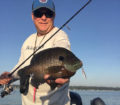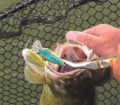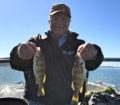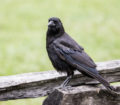By Steve Weisman
Time sure flies. We’re already moving into August, which means Iowa’s September 1 mourning dove season is just about upon us. Since the dove season was established in 2011, it has become an extremely popular early hunting season for Iowa hunters. Iowa DNR data shows that on average 104,000 doves have been harvested annually by 10,400 hunters or an average of 10 doves per hunter for the season. In addition to the mourning dove, there is also the Eurasian collard-dove, which is similar in appearance but has a distinctive mark or “collar” on their neck and are a little larger than the mourning dove. The Eurasian collard-dove can be legally bagged.
For 2019, dove hunters in all counties can expect to find huntable populations, but according to the Iowa DNR, the highest counties will be in the Loess Hills area and the southern three tier of counties. What’s nice is that even though it will probably be warm and humid is that you don’t need a lot of equipment. Just you, your shotgun, a lot of shells, a bucket to sit on and to carry out the bagged doves and a spot that has doves using the area you plan on hunting. Of course, a good dog can help you find the downed dove when it lands in cover. That’s about the best conservation you can do-make sure that all downed birds get recovered.
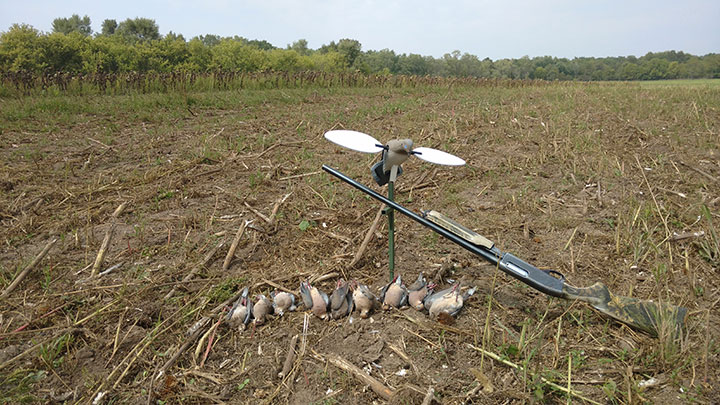
(Photo by Lowell Washburn)
Before the season begins
Scout! That one word can tip the odds in your favor. Get out at least a week in advance and see where the doves are located. Even though they are pretty much anywhere, concentrations of doves occur based on certain key factors. Check spots both early morning and early evening and try to figure out the flight pattern.
Mourning doves like feeding on open ground, eating a variety of seeds and grains. As a result, several DNR wildlife areas in each county have food plots that have been planted to attract doves. Portions of these food plots will be cut down/disked a few days prior to the season to help attract doves to the area. The Iowa DNR has a list of public wildlife areas and private land enrolled in Iowa Habitat Access Program (IHAP) where dove plots – primarily sunflowers – have been added. In 2018, the wet weather impeded the planting process and a lot of plots never got planted. This year has also been a struggle in some areas, so don’t go to a public area and just expect the food plot to be there.
Ideal location
If you had to pick the perfect spot, it would probably be a harvested/disked sunflower field with a pond or slough in the area and a nearby roosting area. Look for good areas to hide like the rest of a standing sunflower field, standing corn, a good fence line, tall prairie grasses or even a thicket or tree.
If you are hunting a public area, expect there will be other hunters in the area. For that reason, make sure there are several different hiding spots. A hiding area that puts the sun at your back is important if possible. Early and late…those are the two best hunting times: the first two hours and the last two hours.
Avoid this pitfall: showing up at sunrise or an hour before sunset. You will be disappointed with other hunters around and they won’t be very happy with you showing up at shooting time.
Don’t be afraid to check out private land that meets all of the things that attract doves. Find out the landowner and see if you can get permission to hunt. Courtesy and respect for the landowner and the landowner’s property will go a long ways in nurturing a potential friendship.
Weather
Weather is very seldom exactly perfect. It might be hot and sticky, foggy, cold and windy…when it’s the opener, hunters just plain go. However, the perfect conditions for a dove hunt would include a cool morning in the 40s-50s or a mild evening with temperatures slowly cooling off into the upper 50s with a slight breeze to keep the bugs away (don’t forget the bug spray) and to keep you cool.
The hunt
Make sure to get to the area before the “optimum” hunting time and get concealed in a place where you can readily bring the shotgun up for a clear shot. Set up so that the shot will be inside 30 yards. When the doves do come through, expect them to come zipping through like little missiles. They rarely give hunters an “in your face” shot. Rather it’s zig and a zag. For that reason, don’t fall into the trap of flock shooting in hopes of dropping one. Do your best to pick one out of the flock.
Realize that if there are lots of doves around, you will probably go through a box or more of shells. A good hunting dog will mark and then find downed birds. Definitely a good warm-up for your hunting dog, too! If you don’t have a dog, then mark and take a line right to the spot. Don’t wait to get the bird later.
Yes, it’ll be hot, so bring plenty of water for both hunter and dog. Dehydration can be an issue. Bring the bug spray and the sunscreen. Dove hunters will often carry a camouflaged five or six-gallon pail for storage and to sit on. Blaze orange is not required. However, it is suggested that hunters wear and orange cap or vest while walking to and from the field for safety
Regulations
Since doves are considered a migratory game bird, hunters will need to have a plug in their gun limiting them to three shells and must register with the Harvest Information Program before they go hunting. Hunters will need to register with Harvest Information Program before hunting doves and other migratory birds. Go to www.iowadnr.gov and click on Buy a Hunting or Fishing License link and then follow the prompts to get to the screen with a link to register to hunt doves.
Hunters are required to have a valid Iowa small game hunting license and the habitat fee to hunt doves. Shooting hours are one-half hour before sunrise to sunset. The daily bag limit is 15 doves with a possession limit of 30. Hunters must have a plug in their shotgun just as they would during the waterfowl season later in the fall.
Great eating
You bet, but do things right. It all begins with cleaning the birds soon after the hunt. If you are going to be in the field for several hours, putting the bagged birds on ice will help ensure that the birds will be brought home in good shape. Once home, breast the birds and wash them in cool water.
My choice is to marinate the breasts in Italian dressing overnight and then grill them the next day, but don’t over grill and make the breasts tough. How about this one? Cut the breasts in half and wrap them in bacon. Pair them with jalapeno peppers. Mix cream cheese, sharp Cheddar cheese, jalapeno peppers halved lengthwise with seeds and membranes removed and wrap with bacon.
Yes, enjoy. Bon Appetit!
The results of a great dove hunt. Location, location, location.

